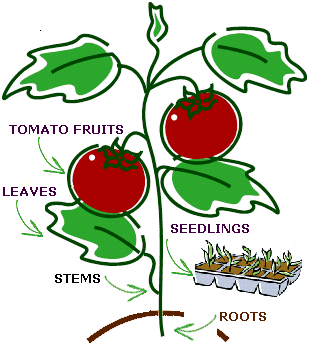OUTDOOR TOMATO PESTS AND DISEASES IN THE UK
This article will help you identify which pest or disease is affecting your tomato plant and the options you have, both natural and chemical, for treating the problem. With our unique step by step identification process you can easily narrow down the problem which is affecting your plant in simple steps. There are thirty plus diseases that can affect tomatoes and probably just as many pests but the good news is that most of these affect greenhouse grown tomatoes and have little or no effect on tomatoes grown outdoors.
STEP 1
Identify which part of your tomato plant is affected with pest or disease by clicking on the relevant part of the diagram below, fruits, leaves, seedlings, stems or roots. Clicking on an affected part will take you to a new page which deals exclusively with all the tomato pests or diseases which can attack that particular area. If more than one area of your tomato plant has a problem, click on the area that is affected the worst, you can always return to to recheck the other areas.
GENERAL ADVICE FOR GROWING HEALTHY OUTDOOR TOMATOES
Using the above diagnostic tools will help you identify and treat specific problems with your tomato plants. However there are a few general cultivation tips which will go a long way towards avoiding many of the problems in the first place. These apply equally to growing tomatoes in the ground, grow-bags and containers.
- Cleanliness is a vital rule with tomato plants. Many pests and diseases start off first in decaying foliage left near the base of the plant. Clearing up dead leaves and other decaying matter near the plant is vital.
- Watering to ensure a constant and even supply of moisture at the roots is crucial for healthy plants. Tomatoes hate stress and uneven watering causes just that.
- Pruning is key if you want the best crop of tomatoes but as far as pests and diseases are concerned concentrate on removing foliage near ground level. Any leaves or stems touching the ground or within 5cm / 2in of it are primary targets for soil borne pests and diseases.
- Keep foliage as dry as possible. A constant and even supply of water is very important for tomatoes but it is the roots which need the moisture not the foliage. Water on foliage, especially at night time, is a magnet for diseases as far as tomatoes are concerned.
